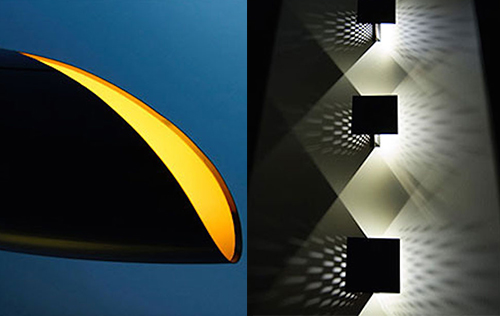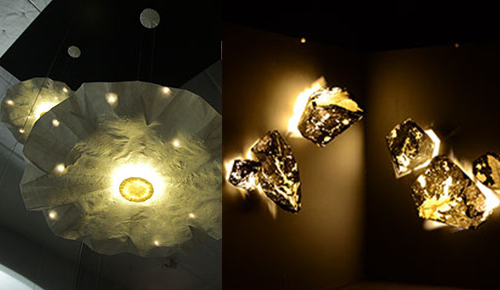
Inspired by invisible depths of both light and shadow in urushi, the “Continuum” family of luminaires is a meditation on the seamless relationship between light and shadow. By Connie Bakshi, Kouichi Miyazaki
Mokume lights that use wood grain to reveal the passage of time. Pendant lights that echo the ephemeral life of the raindrop. Porcelain luminaires that freeze calligraphy, revealing the beauty of the form’s imperfections. These are a few of the projects that emerged from the 9th annual Pacific Rim international collaboration between Art Center and Tama Art University in Tokyo. Hosted and lead by the Environmental Design Department, Pacific Rim challenges students from both schools each year to collaborate to envision new lighting designs by exploring the way light impacts the way we perceive our world, influences our mood and colors our experiences. This year’s collaboration encouraged students to investigate the sensorial qualities of light and shadow within the context of Japanese history, tradition and culture.
Several of the top design projects were recently presented in Milan at Salone Internazionale del Mobile, the largest furniture and furnishing accessories trade fair with the world, as part of an Environmental Design Department exhibition.
The Pacific Rim project beings with a two-week field research trip to experience the history of Japan’s rich arts and craft heritage. Visits to cultural and historical sites and leading contemporary design studios help lay a foundation and generate inspiration for each student’s work. Environmental Design student Rita Jiang was inspired by a visit to Zen gardens to create Karetaki wall and pendant lights that are digital abstractions of the rocks found in the gardens. As viewers pass by, the interactive lights mesmerize with glowing patterns created by sumi ink applied on top of special sumi resist painting.
“The result is an integration of traditional Japanese craft and digital technology that elevates the value of both,” explains Jiang.

“Two Tone,” washi paper lighting integrates traditional craft and digital technology. By Lia Brewster & Rita Jiang
Pacific Rim was launched in 2006 in the spirit of cooperation and partnership between the U.S. and Japan—a particularly influential partnership, given the two nations’ global leadership in the field of industrial design and the power of industrial design to impact the world economy.
For Connie Bakshi, also an Environmental Design student, connecting with Japan provided invaluable insights on the nature of minimalism in design and the ephemeralness of daily life. “The beauty of Japanese culture lies in its sensory refinement and tradition of slow absorption,” she says. “Japanese design language eliminates the unnecessary in order to create a profound emotional and sensorial impact.”
The same could be said of her Continuum lighting collection, which combines digital fabrication with urushi, a traditional Japanese finishing technique, to create a meditation on the seamless relationship between light and shadow.
The opportunity to meet with experts in both contemporary lighting technology and tradition Japanese techniques makes Pacific Rim unique among experiences for Art Center Environmental Design students. Designers were able to meet with Dr. Takeo Yasuda, advanced lighting engineer for Toshiba (Toshiba International Foundation provided critical funding for Pacific Rim); and learned directly from urushi master Akiraka Takagi.
For both Jiang and Bakshi, having their work showcased at Salone del Mobile was an unexpected bonus to their Pacific Rim experience. “It was truly an honor to have my work presented there,” Jiang says. “I got to talk to people from all over the world, which helped make me more confident, more outgoing and better able to speak to other people about my work.”
“Milan Design Week is one of those unforgettable firsts in a designer’s career,” adds Bakshi. “It’s an unparalleled hotbed of inspiration and talent assembled in one place. The experience gave me so much clarity as to where I am in my development and where I’m headed in the future.”
Art Center is most grateful for grant support from Toshiba International Foundation, which enabled the students to participate in the project without incurring significant financial burden.









Excellent raw ! Congratulations !
How beautiful the students show the beauty of Japanese culture.
Knowledge never hurts.